The global vanillin market is valued at USD 850.3 million in 2025 and is slated to reach USD 1,434.2 million by 2035, recording an absolute increase of USD 583.9 million over the forecast period. This translates into a total growth of 68.7%, with the market forecast to expand at a compound annual growth rate (CAGR) of 6.9% between 2025 and 2035. The overall market size is expected to grow by nearly 1.69X during the same period, supported by increasing demand for flavored food products, expanding applications in pharmaceuticals and cosmetics, and growing consumer preference for clean-label ingredients.
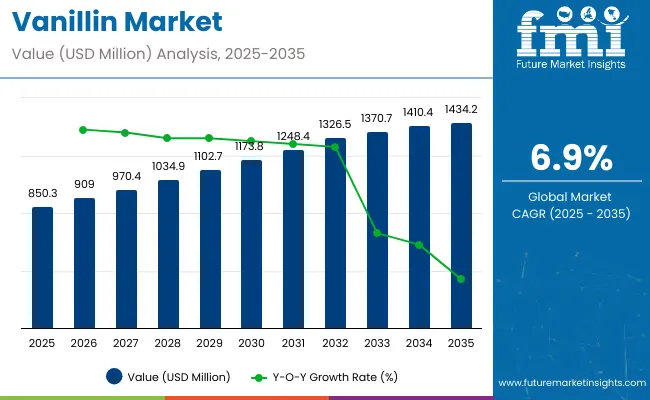
Vanillin Market Key Takeaways
| Metric | Value |
|---|---|
| Estimated Value in (2025E) | USD 850.3 million |
| Forecast Value in (2035F) | USD 1,434.2 million |
| Forecast CAGR (2025 to 2035) | 6.9% |
Between 2020 and 2025, the vanillin market experienced robust expansion, driven by increasing consumer focus on flavor enhancement and growing awareness of food quality improvements. The market developed as food manufacturers recognized the need for effective flavoring solutions to combat bland tastes and enhance consumer satisfaction. Social media influence and chef recommendations began emphasizing the importance of vanillin in food preparation for maintaining appetizing flavor profiles.
Between 2025 and 2030, the vanillin market is projected to expand from USD 850.3 million to USD 1,109.2 million, resulting in a value increase of USD 258.9 million, which represents 44.3% of the total forecast growth for the decade. This phase of growth will be shaped by rising consumer awareness about flavoring benefits, increasing demand for natural and clean-label formulations, and growing penetration of premium food and beverage products in emerging markets. Food and beverage manufacturers are expanding their vanillin product portfolios to address the growing demand for multifunctional flavoring solutions.
From 2030 to 2035, the market is forecast to grow from USD 1,109.2 million to USD 1,434.2 million, adding another USD 325.0 million, which constitutes 55.7% of the overall ten-year expansion. This period is expected to be characterized by expansion of e-commerce channels, integration of advanced production technologies in formulations, and development of personalized flavoring solutions. The growing adoption of natural and bio-based trends and pharmaceutical-recommended products will drive demand for premium vanillin products with enhanced efficacy and safety profiles.
Market expansion is being supported by the increasing consumer awareness about the importance of flavor enhancement in food and beverage products and the corresponding demand for effective flavoring agents. Modern consumers are increasingly focused on taste experience that can enhance their dining satisfaction, improve product appeal, and deliver consistent flavor profiles. Vanillin's proven efficacy in providing vanilla flavor and supporting taste enhancement makes it a preferred ingredient in premium food and beverage formulations.
The growing emphasis on clean-label ingredients and natural flavoring is driving demand for vanillin products derived from natural sources such as vanilla beans and lignin. Consumer preference for multifunctional products that combine flavoring with preservation benefits is creating opportunities for innovative formulations. The rising influence of social media food trends and chef recommendations is also contributing to increased product adoption across different demographics and culinary applications.
The market is segmented by application, source, form, and region. By application, the market is divided into food, beverage, pharmaceuticals, and other applications. Based on source, the market is categorized into natural vanillin and synthetic vanillin. In terms of form, the market is segmented into powder and liquid. Regionally, the market is divided into North America, Latin America, Europe, East Asia, South Asia & Pacific, and Middle East & Africa.
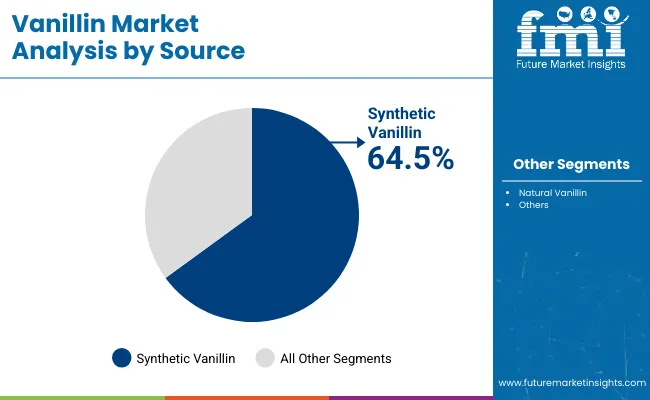
The synthetic vanillin segment is projected to account for 64.5% of the vanillin market in 2025, reaffirming its position as the category's dominant source. Consumers and manufacturers increasingly understand the benefits of synthetic vanillin, such as cost-effectiveness, consistent quality, and reliable supply compared to natural alternatives. Synthetic vanillin's well-documented flavor properties directly address market needs by providing consistent vanilla taste, preventing flavor variations, and supporting product standardization.
This segment forms the foundation of most product positioning, as it represents the most accessible and economically viable source of vanillin for large-scale applications. Regulatory approvals and ongoing safety validation continue to strengthen trust in synthetic vanillin formulations. With manufacturing requirements demanding consistent quality and cost control, synthetic vanillin aligns with both commercial viability and performance goals. Its broad appeal across industrial applications ensures sustained dominance, making it the central growth driver of vanillin market demand.
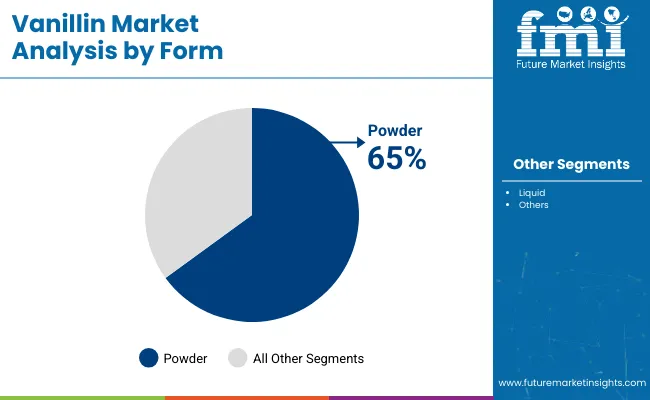
Powder form is projected to represent 65.0% of vanillin demand in 2025, underscoring its role as the preferred form for versatile flavoring applications. Manufacturers gravitate toward powder vanillin for its ease of storage, accurate dosing capabilities, and ability to be incorporated into various formulations, maximizing the utility of vanillin actives. Positioned as convenient, standardized ingredients, powder vanillin offers both processing benefits, such as uniform distribution, and functional benefits, including extended shelf life and stable flavor delivery.
The segment is supported by the rising popularity of baking and confectionery applications, where powder vanillin plays a central role in recipe formulations. Additionally, manufacturers are increasingly combining powder vanillin with complementary ingredients like sugars, stabilizers, or other flavorings, enhancing appeal and justifying competitive pricing strategies. As food processors prioritize convenience and consistency, vanillin-based powder formulations will continue to dominate demand, reinforcing their practical positioning within the flavoring market.
The vanillin market is advancing rapidly due to increasing consumer demand for flavor enhancement and growing adoption of multifunctional food ingredients. However, the market faces challenges including raw material price volatility, supply chain constraints, and competition from alternative flavoring agents. Innovation in production technologies and sustainable sourcing practices continue to influence product development and market expansion patterns.
Expansion of E-commerce and Direct-to-Consumer Channels
The growing adoption of e-commerce platforms is enabling manufacturers to reach consumers directly and provide detailed product information about vanillin applications. Online channels offer convenience, comprehensive product specifications, and customer reviews that influence purchasing decisions. Digital marketing and food blogger partnerships are driving brand awareness and product adoption, particularly among home bakers and small-scale food producers who prefer online shopping experiences.
Integration of Advanced Production Systems and Manufacturing Technologies
Modern vanillin manufacturers are incorporating advanced production systems such as enzymatic synthesis, fermentation technologies, and purification processes to enhance product quality and production efficiency. These technologies improve the consistency of vanillin while reducing production costs and providing better manufacturing scalability. Advanced production techniques also enable specialized formulations that deliver multiple benefits in single applications.
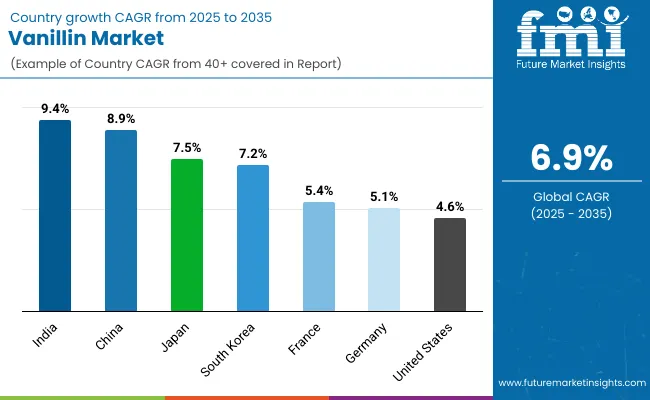
| Country | CAGR (2025 to 2035) |
|---|---|
| India | 9.4% |
| China | 8.9% |
| Japan | 7.5% |
| South Korea | 7.2% |
| France | 5.4% |
| Germany | 5.1% |
| United States | 4.6% |
The vanillin market is experiencing robust growth globally, with India leading at a 9.4% CAGR through 2035, driven by rising disposable income, expanding food processing industry, and growing penetration of flavored products. China follows closely at 8.9%, supported by strong manufacturing capabilities, increasing food consumption, and rising demand for processed foods. Japan shows steady growth at 7.5%, emphasizing quality formulations and advanced food technologies. South Korea records 7.2%, focusing on premium food applications and innovative flavor technologies. France shows 5.4% growth, driven by its culinary heritage and premium food manufacturing sector. Germany records 5.1%, focusing on natural ingredients and premium food applications. The United States shows 4.6% growth, prioritizing clean-label ingredients and sustainable food practices.
The report covers an in-depth analysis of 40+ countries; seven top-performing countries are highlighted below.
Revenue from vanillin in China is projected to exhibit strong growth with a CAGR of 8.9% through 2035, driven by rapid expansion of food processing industries and increasing adoption of flavored products among consumers. The country's large-scale manufacturing capabilities and growing food consumption are creating significant demand for cost-effective flavoring solutions. Major international and domestic food manufacturers are establishing comprehensive production networks to serve the growing population of flavor-conscious consumers across tier-1 and tier-2 cities.
Revenue from vanillin in India is expanding at a CAGR of 9.4%, supported by increasing disposable income, growing food processing sector, and rising penetration of packaged food products. The country's young demographic profile and increasing exposure to international food trends are driving demand for effective flavoring solutions. International food manufacturers and domestic processors are establishing distribution channels to serve the growing demand for quality food ingredients.
Demand for vanillin in the USA is projected to grow at a CAGR of 4.6%, supported by consumer preference for clean-label products and natural flavoring solutions. American consumers are increasingly focused on ingredient transparency, product safety, and sustainable food practices. The market is characterized by strong demand for natural formulations that combine vanillin with other complementary ingredients for enhanced food applications.
Revenue from vanillin in Japan is projected to grow at a CAGR of 7.5% through 2035, driven by the country's strong focus on food technology, premium product positioning, and consumer preference for high-quality formulations. Japanese consumers consistently demand superior taste, multifunctional products that deliver consistent results while maintaining ingredient purity.
Revenue from vanillin in South Korea is projected to grow at a CAGR of 7.2% through 2035, supported by the country's advanced food processing capabilities and strong consumer demand for premium flavored products. Korean consumers show increasing preference for high-quality food ingredients and innovative flavor profiles in processed foods and beverages.
Revenue from vanillin in France is projected to grow at a CAGR of 5.4% through 2035, supported by the country's rich culinary heritage and strong premium food manufacturing sector. French consumers value traditional flavor profiles combined with innovative food technologies, positioning vanillin as an essential ingredient in both artisanal and industrial food production.
Revenue from vanillin in Germany is projected to grow at a CAGR of 5.1% through 2035, supported by rising consumer interest in natural ingredients and multifunctional food solutions. German consumers value ingredient quality, sustainability, and proven efficacy, positioning vanillin as a core component of premium food formulations.
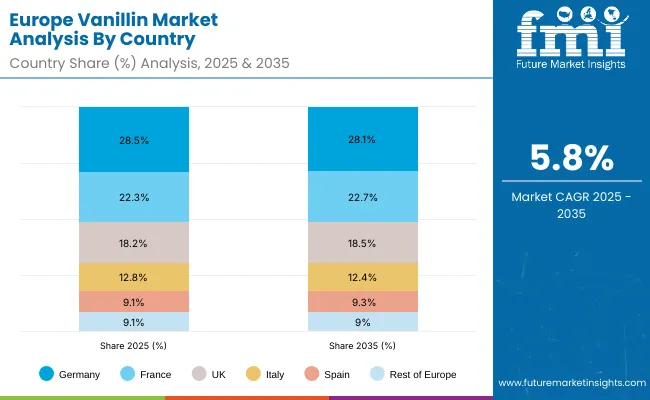
The vanillin market in Europe is projected to grow at a CAGR of 5.8% over the forecast period. Germany is expected to lead the region with 28.5% market share in 2025, moderating slightly to 28.1% by 2035, supported by its advanced food processing industry and strong demand for premium flavoring ingredients in bakery and confectionery applications. France follows with 22.3% in 2025, rising to 22.7% by 2035, driven by its rich culinary heritage, premium food manufacturing sector, and sophisticated understanding of flavor science in artisanal and industrial food production.
The United Kingdom accounts for 18.2% in 2025, edging to 18.5% by 2035 as clean-label trends and ingredient transparency drive demand for natural vanillin formulations. Italy holds 12.8% in 2025, easing to 12.4% by 2035, with growth concentrated in premium food applications and traditional Italian food manufacturing. Spain represents 9.1% in 2025, moving to 9.3% by 2035, supported by expanding food processing capabilities and rising demand for flavored products.
The remainder of Europe (Nordic countries, BENELUX, Eastern Europe and other markets) collectively contributes 9.1% in 2025, adjusting to 9.0% by 2035, reflecting steady growth in food ingredient adoption and expanding access to premium flavoring solutions across diverse retail and industrial channels.
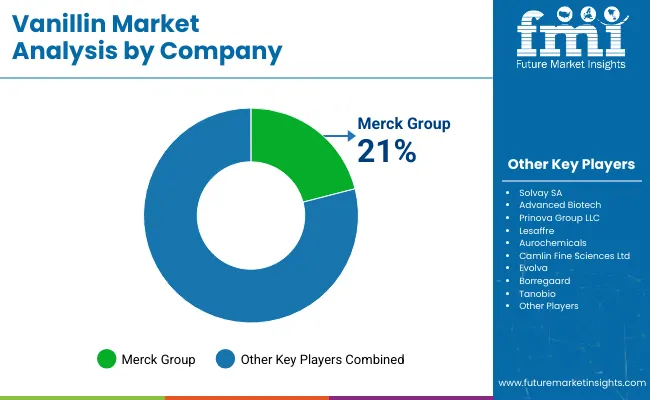
The vanillin market is characterized by competition among established chemical companies, specialty ingredient manufacturers, and emerging biotechnology players. Companies are investing in advanced production technologies, sustainable sourcing practices, premium formulations, and digital marketing strategies to deliver effective, appealing, and accessible vanillin solutions. Brand positioning, production innovation, and distribution expansion are central to strengthening product portfolios and market presence.
Solvay SA, Belgium-based, leads the market with significant global value share, offering high-quality vanillin formulations with a focus on industrial applications and chemical expertise. Advanced Biotech, USA, provides specialized, biotechnology-derived vanillin products with emphasis on natural production methods and innovative manufacturing. Prinova Group LLC, USA, delivers comprehensive ingredient solutions with focus on food industry applications and customer service. Lesaffre, France, focuses on fermentation-based production methods that combine vanillin with biotechnology expertise.
Aurochemicals, India, and Camlin Fine Sciences Ltd, India, operating regionally, provide comprehensive vanillin product ranges across multiple price points and application areas. Merck Group, Germany, emphasizes pharmaceutical-grade ingredients and high-purity formulations with premium positioning. Evolva, Switzerland, offers biotechnology-developed products with sustainable production methods and innovative approaches. Borregaard and Tanobio provide specialized solutions with focus on specific applications and natural ingredient preferences.
The success of vanillin, driven by rising demand in food, beverages, pharmaceuticals, and cosmetics, will not only expand access to affordable flavoring but also strengthen global sustainability in aroma ingredients. It will consolidate emerging markets as production hubs for synthetic and bio-based vanillin while aligning advanced economies with clean-label, ESG-compliant, and traceable flavor solutions. This calls for a concerted effort by all stakeholders: governments, industry bodies, suppliers, OEMs, and investors. Each can be a crucial enabler in preparing the market for its next phase of growth.
| Items | Values |
|---|---|
| Quantitative Units (2025) | USD 850.3 Million |
| Application | Food, Beverage, Pharmaceuticals, Other Applications |
| Source | Natural Vanillin, Synthetic Vanillin |
| Form | Powder, Liquid |
| Regions Covered | North America, Latin America, Europe, East Asia, South Asia & Pacific, Middle East & Africa |
| Countries Covered | United States, Canada, United Kingdom, Germany, France, China, Japan, South Korea, India, Brazil, Australia and 40+ countries |
| Key Companies Profiled | Solvay SA, Advanced Biotech, Prinova Group LLC, Lesaffre, Aurochemicals, Camlin Fine Sciences Ltd, Merck Group, Evolva, Borregaard, and Tanobio |
| Additional Attributes | Dollar sales by vanillin type and concentration level, regional demand trends, competitive landscape, buyer preferences for natural versus synthetic sources, integration with clean-label positioning, innovations in production technologies, enzymatic synthesis, and sustainable sourcing practices |
The market is projected to reach USD 1,434.2 million by 2035.
The market is expected to grow at a CAGR of 6.9% from 2025 to 2035.
India is expected to register the fastest growth in the market, with a projected CAGR of 9.3%.
Key companies include Solvay SA, Merck Group, Camlin Fine Sciences Ltd., Borregaard, Evolva, Prinova Group LLC, Advanced Biotech, Lesaffre, Aurochemicals, and Tanobio.






Our Research Products

The "Full Research Suite" delivers actionable market intel, deep dives on markets or technologies, so clients act faster, cut risk, and unlock growth.

The Leaderboard benchmarks and ranks top vendors, classifying them as Established Leaders, Leading Challengers, or Disruptors & Challengers.

Locates where complements amplify value and substitutes erode it, forecasting net impact by horizon

We deliver granular, decision-grade intel: market sizing, 5-year forecasts, pricing, adoption, usage, revenue, and operational KPIs—plus competitor tracking, regulation, and value chains—across 60 countries broadly.

Spot the shifts before they hit your P&L. We track inflection points, adoption curves, pricing moves, and ecosystem plays to show where demand is heading, why it is changing, and what to do next across high-growth markets and disruptive tech

Real-time reads of user behavior. We track shifting priorities, perceptions of today’s and next-gen services, and provider experience, then pace how fast tech moves from trial to adoption, blending buyer, consumer, and channel inputs with social signals (#WhySwitch, #UX).

Partner with our analyst team to build a custom report designed around your business priorities. From analysing market trends to assessing competitors or crafting bespoke datasets, we tailor insights to your needs.
Supplier Intelligence
Discovery & Profiling
Capacity & Footprint
Performance & Risk
Compliance & Governance
Commercial Readiness
Who Supplies Whom
Scorecards & Shortlists
Playbooks & Docs
Category Intelligence
Definition & Scope
Demand & Use Cases
Cost Drivers
Market Structure
Supply Chain Map
Trade & Policy
Operating Norms
Deliverables
Buyer Intelligence
Account Basics
Spend & Scope
Procurement Model
Vendor Requirements
Terms & Policies
Entry Strategy
Pain Points & Triggers
Outputs
Pricing Analysis
Benchmarks
Trends
Should-Cost
Indexation
Landed Cost
Commercial Terms
Deliverables
Brand Analysis
Positioning & Value Prop
Share & Presence
Customer Evidence
Go-to-Market
Digital & Reputation
Compliance & Trust
KPIs & Gaps
Outputs
Full Research Suite comprises of:
Market outlook & trends analysis
Interviews & case studies
Strategic recommendations
Vendor profiles & capabilities analysis
5-year forecasts
8 regions and 60+ country-level data splits
Market segment data splits
12 months of continuous data updates
DELIVERED AS:
PDF EXCEL ONLINE
Bio Vanillin Market Analysis - Size, Share, and Forecast Outlook 2025 to 2035
Ethyl Vanillin Market Analysis by Product Type, Form, Application and Region from 2025 to 2035
Demand for Vanillin in EU Size and Share Forecast Outlook 2025 to 2035

Thank you!
You will receive an email from our Business Development Manager. Please be sure to check your SPAM/JUNK folder too.
Chat With
MaRIA